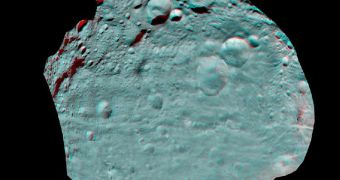After arriving at the largest asteroid in our solar system about a month ago, a NASA space probe has now succeeded in entering the first of four science orbits it needs to take around the space body. This marks the first time a spacecraft is orbiting an object of interest in the Inner Asteroid Belt (IAB).
The NASA Dawn space probe is propelled by an ion thruster, which allows it to move more smoothly than most other spacecraft of its type. Even as it entered orbit around the asteroid Vesta, on July 16, the vehicle did not carry out any maneuvers, but achieved a direct insertion into the proper burning.
By August 11 at 9:13 am PDT (12:13 am EDT, 1613 GMT), the spacecraft was fully commissioned and began conducting observations of the protoplanet. At that time, it was on a so-called survey orbit, the first and highest possible around Vesta.
From an altitude of around 1700 miles (2700 kilometers), Dawn mission engineers at the NASA Jet Propulsion Laboratory (JPL) programmed the spacecraft to collect overview images of the protoplanet.
The visible-light and infrared instruments on the spacecraft will be mapping the entire surface of the object during this time. The mapping spectrometer (VIR) instrument is the primary tool for doing this.
At the same time, the framing camera instrument will be used to complement by VIR spectral data by producing mosaic images of the geology and composition of Vesta's surface. Background data of the asteroid will be collected using the gamma ray and neutron detectors on the space probe.
Another objective is studying the gravity field around Vesta, by using a radio instrument. This works by conducting precise calculations of the vehicle's position around the asteroid. The technique allowed JPL experts managing the Cassini spacecraft to study the distribution of material inside several moons.
According to mission scientists, the entire survey phase will last for about 20 days, allowing for a total of 7 full orbits around the asteroid. Once this stage of the mission is complete, the probe will fire its ion engines again, in order to spiral down to a lower orbit.
In late September, Dawn will enter its second science High Altitude Mapping Orbit (HAMO), which will enable it to snap closer, more detailed views of the protoplanet's surface. A full orbit will take just half a day to complete, as opposed to the three days it takes to complete a survey phase orbit.
The HAMO phase will last for about 30 days, until Dawn completes 60 orbits around Vesta. During this time, the illuminated portions of the asteroid will be mapped in full and at great levels of detail.
Dawn launched in September 2007 and arrived at Vesta in July 2011. Following a year at Vesta, the spacecraft will depart in July 2012 for the dwarf planet Ceres, where it will arrive in 2015. Dawn's mission to Vesta and Ceres is managed by the JPL.

 14 DAY TRIAL //
14 DAY TRIAL //